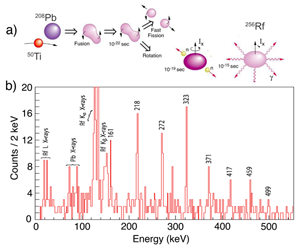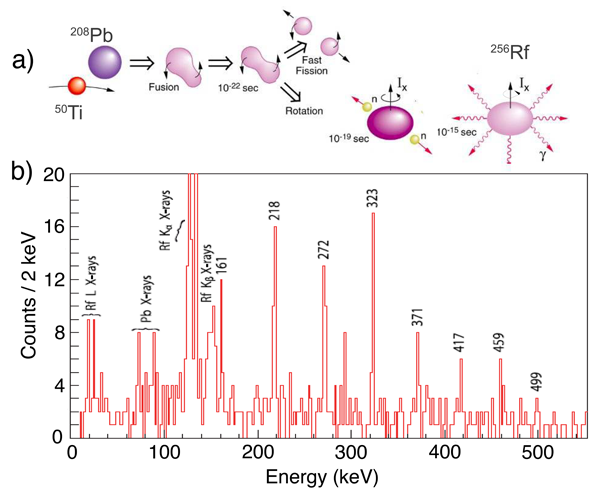Putting a Spin on Superheavy Elements
The charged liquid-drop model portrays atomic nuclei as spherical and amorphous collections of nucleons whose stability is determined by competition between the attractive strong interaction and repulsive Coulomb and surface-energy terms. For stable nuclei, the strong interaction wins, creating a barrier against fission, but this barrier diminishes as the nucleus grows larger. As a result, the liquid-drop model predicts that nuclei with atomic number should not exist at all. However, some elements beyond this limit—known as “superheavy”—do, in fact, exist, albeit with very short lifetimes. These nuclei achieve their relative stability through a variety of effects, including departure from sphericity, pairing up of nucleons, and quantum-mechanical shell effects, in which large numbers of nucleons form into energetically favorable structures within the nucleus.
The notion of shell stabilization leads to the prediction of an “island of stability” occupied by relatively long-lived, but as yet, unknown superheavy nuclei with “magic numbers” of protons and nucleons, variously predicted to be centered on , , or [1]. The quest for new superheavy elements has recently neared this island of stability with the discovery of elements , , , and , in experiments at the Joint Institute for Nuclear Research in Dubna, Russia [2]. However, these elements can currently be produced only with neutron numbers below the predicted magic number . While the observations are generally consistent with the existence of a region of more stable isotopes, the shell structure of superheavy nuclei is still not clearly established.
Writing in Physical Review Letters, Paul Greenlees et al. [3] describe experiments that address the structure of superheavy nuclei with a new level of sensitivity and detail. The team, an international collaboration of scientists working at the cyclotron laboratory of the University of Jyväskylä, Finland, measured the characteristic gamma-spectrum of the nucleus Rutherfordium ( ). This is the heaviest nucleus for which such spectra have been measured to date. By obtaining a more detailed view of a slightly less exotic isotope, this work is complementary to experiments aiming to establish directly the existence of new elements in the island of stability. In particular, Greenlees et al. investigate modification of shell structure due to a quadrupole deformation of the shape of the nucleus, an effect that is usually assumed to stabilize the nuclei around .
As in all experimental investigations of superheavy elements, the first challenge is to create a sufficient number of nuclei for study. Greenlees et al. used a high-intensity beam of the isotope , delivered by the Jyväskylä cyclotron, to bombard a thin foil of lead, enriched in the isotope . At a beam energy of , the beam and target nuclei can fuse to form the highly excited compound nucleus , but the odds of the protons sticking together throughout the reaction are staggeringly low. In only about one out of million collisions is the end result a bound state of , reached through the evaporation of two neutrons. All other cases result in fission, yielding lighter isotopes [see Fig. 1(a)].
In order to select these few events of interest and measure the gamma rays emitted as the newly formed nuclei de-excite, the team surrounded the reaction target with high-resolution gamma detectors (the JUROSPHERE array) and used the gas-filled magnetic spectrometer RITU (recoil ion transport unit) to separate the recoiling nuclei. The spectrometer was set to accept the expected nuclei and reject essentially all other particles by selecting a specific trajectory in its magnetic field. The transmitted particles were further characterized and finally stopped by implantation in the GREAT (gamma recoil electron alpha timing) array of charged particle detectors. Even after this careful selection, in combination with other conditions, the unwanted background of scattered beam and fission products was much greater than the rate of detection. One property, however, made stand out from all other particles: its decay by spontaneous fission, with a characteristic half-life of approximately ms. Only when this decay occurred was the recoiling nucleus unequivocally identified as .
One might not expect much benefit from identifying a nucleus only after it ceased to exist, but in the method of decay-implantation correlation, the characteristic decay makes all the difference. The experiment made it possible to trace the history of each decayed nucleus back in time and, using time-of-flight information from the spectrograph, select from the recorded data the gamma rays detected from the reaction in which the nucleus was created. Gamma rays not correlated with a later decay are ignored, and ambiguous assignments can also be rejected. Using this method, Greenlees et al. were able to unequivocally attribute a total of gamma events to , after sorting through gamma rays detected per second over the course of hours of experiment time.
The resulting spectrum of gamma rays from is clean and shows eight peaks, along with x-ray peaks attributable to Rf and Pb [see Fig. 1(b)]. The eight peaks form a familiar picket-fence pattern that is characteristic of emission from a band of rotational states, establishing that , like its lighter neighbors, has a quadrupole-deformed shape. The energy spacing in the spectrum reveals the rotational moment of inertia and the way it varies as a function of rotational frequency. The moment of inertia, in turn, contains information on the orbital level density, in that an energy gap in the orbital structure would increase the moment of inertia. The value observed for turns out to be very similar to its lighter ( ) neighbor Nobelium, a result that contradicts certain theoretical predictions [4] that there should be an orbital energy gap at .
Going into more detail, Greenlees et al. noted a rapid increase of the moment of inertia at the upper end of the gamma-ray spectrum and the highest spins, an effect they attributed to a pair of nucleons breaking apart under the stress of rotation. From this behavior they can deduce which proton orbital in is energetically closest to the Fermi level, which is the highest energy orbital occupied in the ground state of the nucleus. Explaining such detailed information about the shell structure of this deformed, superheavy nucleus is a formidable challenge for present-day theoretical investigations, and opens a pathway to more reliable predictions about the “island of stability” in superheavy nuclei.
The work described here represents the culmination of improvements in the sensitivity of this type of experiment that have been achieved over the course of years. Gamma spectroscopy of a transfermium element was first performed in 1999 on the isotope , using the Gammasphere and the FMA recoil separator at Argonne National Laboratory [5]. The reaction to create that nucleus had a cross section of around microbarn. Since then, groups at Argonne and Jyväskylä have improved the sensitivity of their experiments to a level where the spectrum could be measured from a reaction with a cross section of only about nanobarn. In the field of superheavy nuclear spectroscopy, this increase in sensitivity translates into many opportunities to extend our knowledge into previously unexplored regions.
References
- R.-D. Herzberg and P. T. Greenlees, “In-beam and decay spectroscopy of transfermium nuclei,” Prog. Part. Nucl. Phys. 61, 674 (2008)
- Yu. Ts. Oganessian, “Heaviest nuclei from {48}Ca-induced reactions,” J. Phys. G 34, R165 (2007)
- P. T. Greenlees et al., ”Shell-Structure and Pairing Interaction in Superheavy Nuclei: Rotational Properties of the Z=104 Nucleus 256 Rf,” Phys. Rev. Lett. 109, 012501 (2012)
- A. Afanasjev, T. L. Khoo, S. Frauendorf, G. A. Lalazissis, and I. Ahmad, “Cranked relativistic Hartree-Bogoliubov theory: Probing the gateway to superheavy nuclei,” Phy. Rev. C 67, 024309 (2003)
- P. Reiter et al., “Ground-State Band and Deformation of the Z = 102 Isotope {254}No,” Phys. Rev. Lett. 82, 509 (1999)





